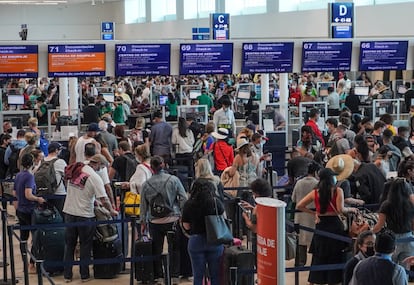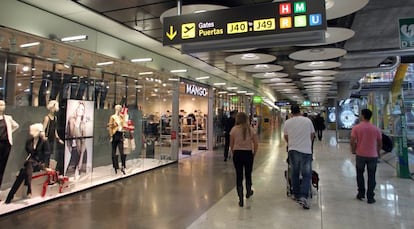Check-ins from home, 3D scanners and trains to boarding gates: What it will be like to fly in the future
Airports are relying on technology to solve travel waits, bottlenecks and check-in problems. Here’s how they may look in the next few years

Over 19 billion passengers will use the world’s airports each year by 2040, according to forecasts by Airports Council International (ACI). That is the equivalent of handling traffic 2.5 times the world’s population. This summer, Spain alone broke 2019 records (1.2% more flights) and will surpass that mark again this winter (12.8% more), according to the Airline Association. Aeropuertos Españoles y Navegación Aérea (Spanish Airports and Air Travel; AENA) expects to reach 280 million travelers this year. This enormous migration is subjected to the tedious process of urban transportation, waiting, check-in, internal movement and controls that are repeated over and over again until the experience becomes a hellish ritual. “Technology is the only way to improve it,” says Ricardo Fernandez, the CEO of Destinia, a digital travel company. A report by the Oliver Wyman international consultancy in collaboration with ACI shows how biometrics, artificial intelligence and automation will shape air travel in the future. This is what flying will be like:
Check-in from home
Rana Nawas, an Oxford-trained engineer specializing in transportation services and the co-author of the latest Oliver Wyman report, makes a strong case that “just because something hasn’t been done yet, doesn’t mean it can’t be done.” In her vision of future airports, she doesn’t hear the incessant rattling of suitcase wheels through the city to the airport connection. “Definitely, the trend is that luggage will be picked up at home or dropped off at a depot,” she asserts. “The barrier to be overcome is really security,” she admits. Ricardo Fernandez sees the issue similarly: “In the short term it’s a bit complicated because, within check-in, weight and size has major implications on the volume that can be allowed in the aircraft hold. But, really, this will not take as long to arrive as digital ticketing or other technologies have taken.”

Connecting the city and the airport
“We see a decrease in the number of people going by car and cab, so it’s a dimension that airports need to think about,” Nawas says. In 2022, Geneva Airport decided to stop expanding parking spaces to instead promote the use of public transport and to use the space taken up by cars for other services. Over half of travelers already dispense with their own vehicles and cabs to get there.
Paul Griffiths, the CEO of Dubai Airport, goes further: “Imagine a train with cars programmed to detach and stay at a specific terminal. That car will take you to where your flight is. Instead of having a road and rail system dropping passengers off at the main terminal, you could get directly to the boarding gates.” Griffiths believes the design of the future airport “needs to be completely rethought.”

Access control
“It’s going to be much more pleasant, fluid and efficient. And that’s not just wishful thinking. It already exists,” Nawas says. “What’s going to happen,” she explains, “is that you’re going to get your boarding pass on your phone, and it will share the information with the airport systems, which will tell you the gate and how to get there. [There] will be a walk along a path where you won’t be stopped [a concept described as On the move]. You will walk and the phone and the airport will share your data, read your biometric parameters and know exactly who you are and [your] immigration status.”
Ricardo Fernandez concurs. “Facial recognition is very commonly used. We already see it in many European and international airports (AENA uses it). The advantages are obvious: it facilitates the work of security agents and the comfort of travelers... as long as the information is not used for commercial purposes.”
Control of personal belongings and carry-on luggage
This is one of the most exasperating stages, as it requires long lines, unpacking, removing shoes, belts and metal objects, emptying pockets and separating devices. In Spain, AENA will be implementing 3D scanners across the board in the next few years. This system takes measurements from different angles to create a final three-dimensional and highly detailed image.” Very soon, it will be mandatory in Europe, and it’s going to be a big step for tourism,” says the Destinia director.
The most recent Gitex Dubai technology fair presented the Gscan, a model capable of identifying the shape and composition of any content through the movement of subatomic particles, which provide a precise image of and information about the inside of any environment. It is designed to analyze everything from large structures to port goods to smaller objects.
A US laboratory and the US Department of Homeland Security’s Science and Technology Directorate have developed a high-definition scanner that can identify minute threats and reduce false positives, as well as a device to check shoes in two seconds without taking them off. “These elements could speed up the screening process by 15% to 20% and optimize security processes while still detecting threats,” says Bill Frain, the director of the company that developed them.
Lawyer Jesús Hernández adds another element to be considered: respect for privacy. “Implementing this type of technology requires guaranteeing that there is no intrusion into people’s privacy by having access to the details of their belongings and even the shape of their bodies. It is not an absolute right, so it can be limited for the sake of security. But you have to find the middle ground,” he says.

Waiting for boarding
“The airport will not only allow shopping, but also entertainment. Passengers are becoming much more sophisticated and demanding. The key to success will be allowing customers to personalize their experience. A business passenger who wants to go fast is different from a family,” the transportation services expert says. Nawas sees commercial offerings linked more to screens through which the customer will be able to buy anything they want and receive it at the boarding gate or reserve a table in restaurants. And the huge space now occupied by stores could be replaced by other services, such as swimming pools, gyms, massage parlors or cinemas.
“Time is more important than ever. If I want to spend it at airports, it should be my choice, not because of lines and checkpoints. We have to use biometrics and artificial intelligence to predict the time we spend in terminals,” Diego Arrosa, Uruguay Airports director, says in the Oliver Wyman report.
The flight
Technology has not yet found solutions here. The limited space available faces several constraints, as well as pressure from low-priced offerings: increasing demand, which forces maximizing the number of passengers per flight; rising costs, which drive airlines to offer smaller, more efficient aircraft to save on fuel and operating costs; and technical safety requirements, which require the availability of free space in case of an emergency. “We don’t have a vision of how this is going, how we can expand it, how we can make it commercially viable,” Nawas concedes.
One key will be providing cheaper sustainable aviation fuels (SAFs), which are also imperative for meeting pollution reduction requirements. “We don’t have the technology to get there yet, but there are a lot of smart people, and many billions of euros are being invested in answering this question,” the engineer says. According to Oliver Wyman’s calculations, up to 20.5 billion liters of SAFs will be available by 2030, but the airline industry will need three times as much just to keep them at 2019 levels (not to get to zero emissions).
Connections and arrival
In Ricardo Fernandez’s view, these circumstances are also a battle to be won. “Aspects such as in-flight connectivity, baggage collection and security screening at the destination can be improved. Technology is the only key to doing so,” he says.
Sign up for our weekly newsletter to get more English-language news coverage from EL PAÍS USA Edition
Tu suscripción se está usando en otro dispositivo
¿Quieres añadir otro usuario a tu suscripción?
Si continúas leyendo en este dispositivo, no se podrá leer en el otro.
FlechaTu suscripción se está usando en otro dispositivo y solo puedes acceder a EL PAÍS desde un dispositivo a la vez.
Si quieres compartir tu cuenta, cambia tu suscripción a la modalidad Premium, así podrás añadir otro usuario. Cada uno accederá con su propia cuenta de email, lo que os permitirá personalizar vuestra experiencia en EL PAÍS.
¿Tienes una suscripción de empresa? Accede aquí para contratar más cuentas.
En el caso de no saber quién está usando tu cuenta, te recomendamos cambiar tu contraseña aquí.
Si decides continuar compartiendo tu cuenta, este mensaje se mostrará en tu dispositivo y en el de la otra persona que está usando tu cuenta de forma indefinida, afectando a tu experiencia de lectura. Puedes consultar aquí los términos y condiciones de la suscripción digital.
More information

Mexico’s jungle airport in Tulum
Últimas noticias
Most viewed
- Sinaloa Cartel war is taking its toll on Los Chapitos
- Oona Chaplin: ‘I told James Cameron that I was living in a treehouse and starting a permaculture project with a friend’
- Reinhard Genzel, Nobel laureate in physics: ‘One-minute videos will never give you the truth’
- Why the price of coffee has skyrocketed: from Brazilian plantations to specialty coffee houses
- Silver prices are going crazy: This is what’s fueling the rally










































